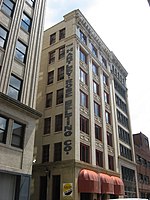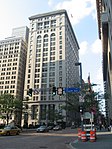The Salvation Army Building (Pittsburgh, Pennsylvania)
Buildings and structures in PittsburghCommercial buildings completed in 1924Commercial buildings on the National Register of Historic Places in PennsylvaniaGothic Revival architecture in PennsylvaniaNational Register of Historic Places in Pittsburgh ... and 2 more
Salvation Army buildingsSkyscraper hotels in Pittsburgh

The Salvation Army Building is a historic building located at 425-435 Boulevard of the Allies in Pittsburgh, Pennsylvania. The building was constructed in 1924 with a large eastern addition in 1930 in the Late Gothic Revival style. The multi-purpose building originally housed the headquarters, residential and recreational functions for the Salvation Army of Western Pennsylvania from 1924 until 2008. It was listed on the National Register of Historic Places on February 2, 2016.It was also known as The People's Institute and The Evangeline Residence for Young Women at different times. The building was redeveloped into the boutique Distrikt Hotel Pittsburgh in 2017.
Excerpt from the Wikipedia article The Salvation Army Building (Pittsburgh, Pennsylvania) (License: CC BY-SA 3.0, Authors, Images).The Salvation Army Building (Pittsburgh, Pennsylvania)
Cherry Way, Pittsburgh
Geographical coordinates (GPS) Address Nearby Places Show on map
Geographical coordinates (GPS)
| Latitude | Longitude |
|---|---|
| N 40.4375 ° | E -79.998888888889 ° |
Address
Salvation Army Temple
Cherry Way
15222 Pittsburgh
Pennsylvania, United States
Open on Google Maps









